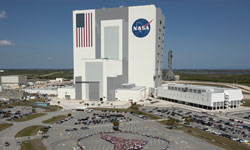Usando Simulación en los Sistemas Astronáuticos y Aeroespaciales
DOI:
https://doi.org/10.31644/IMASD.2.2013.a02Resumen
En este artículo se introducen ideas de simulación y los agentes con sus aplicaciones en el desarrollo de sistemas aeroespaciales y la toma de decisiones en la NASA. En particular los siguientes temas serán discutidos: simulación de los nuevas naves espaciales (MPCF/SLS y CubeSats), simulación continua de la atmosfera marciana y la utilización de agentes.
Descargas
Citas
Bergin, C. (2012). Dynetics and PWR aiming to liquidize SLS booster competition with F-1 power. http://www.nasaspaceflight.com/2012/11/dynetics-pwr-liquidize-sls-booster-competition-f-1-power.
Eddy, M. (2011). A Closer Look at NASA’s Multi-Purpose Crew Vehicle. http://www.geekosystem.com/nasa-mpcv-infographic/.
Judith, D., M. Richard and M. Richard (1998). The DoD high level architecture: an update. 1998 Winter Simulation Conference Proceedings (Cat.No.98CH36274), 797-804.
Marin, M., Y. Zhu, P. Meade, M. Sargent and J. Warren (2006). "System Dynamics and Agent-based Simulations for Workforce Climate," Proceedings of the 2006 Winter Simulation Conference, 667 – 671.
NASA Office of the Chief Technologist (OCT) (2010). DRAFT Modeling, Simulation, Information Technology & Processing Roadmap Technology Area 11 http://www.nasa.gov/pdf/501321main_TA11-MSITP-DRAFT-Nov2010-A1.pdf.
Matson, J. (2013). "Can Hitchhiking Earth Microbes Thrive on Mars?," Scientific American.
Rabelo, L. (2003). "Ambientes Avanzados para la Toma de Decisiones," Politica Digital, publicación de Nexos, Vol. 12, pp. 14-18.
Rabelo L., Y. Zhu, J. Compton and J. Bardina (2011). "Ground and Range Operations for a Heavy-Lift Vehicle: Preliminary Thoughts," International Journal of Aerospace, Vol. 4, No. 2, 1064-1073.
Review of U.S. Human Spaceflight Plans Committee (2009). Seeking a Human Spaceflight Program Worthy of a Great Nation, NASA Publications. http://spacegrant.nmsu.edu/ispcs/2009/news/augustin_report.pdf.
























